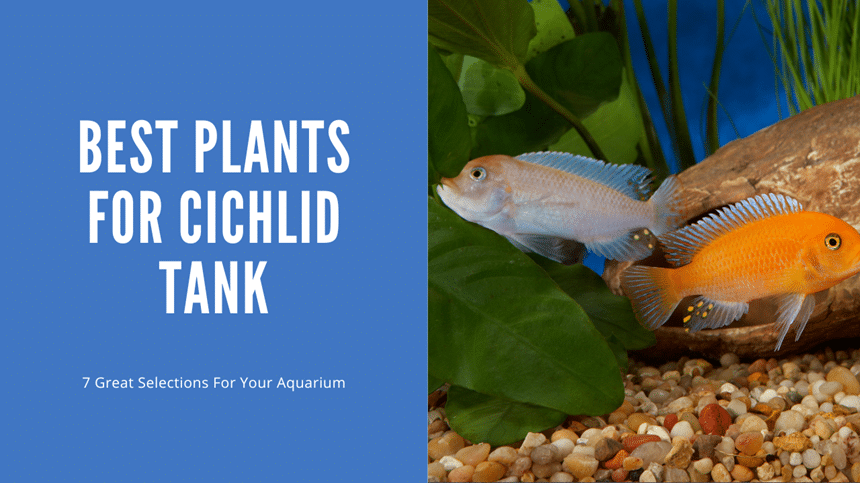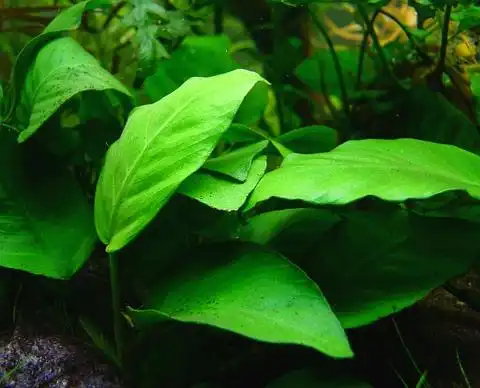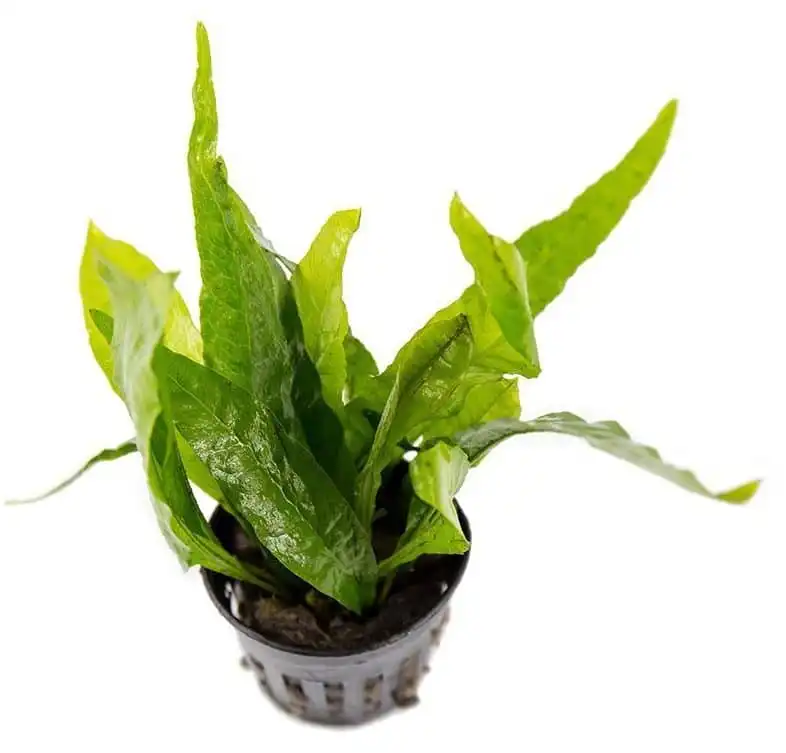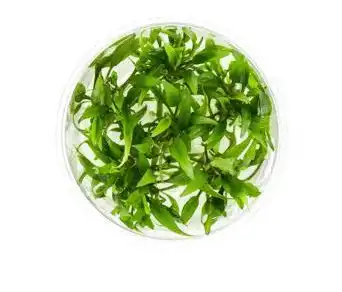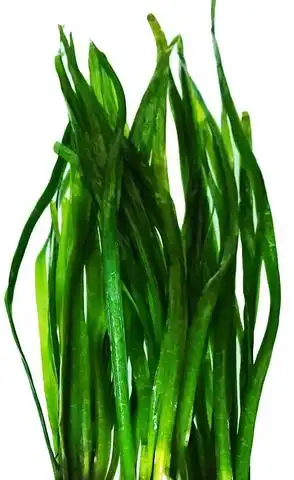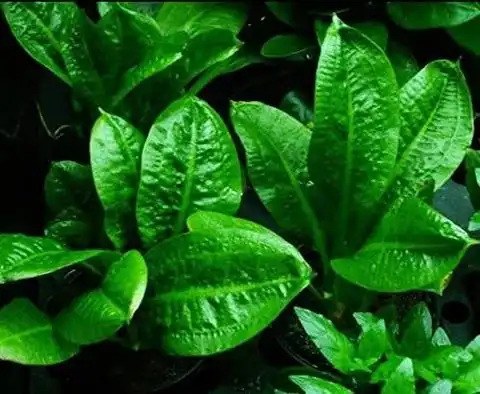Thank you for visiting! By the way… any links on this page that lead to products on Amazon and other stores/partners are affiliate links Aquarium Store Depot earns a commission if you make a purchase.
Cichlids are aggressive towards each other, but are they aggressive to live plants? Most Central and South American cichlids can be kept with a variety of aquarium plants, but African species are more challenging to pair due to water parameters. It’s not impossible though!
Keep reading to find out everything you need to know about keeping aquatic plants with cichlids and some ideas for the best species to keep in a planted tank!
Key Takeaways
- African, Central, and South American cichlids can be kept with popular aquatic plants, like Anubias, Java fern, and Cryptocoryne.
- Plant species are limited by water parameters and cichlid behavior.
- Some cichlids will rip plants from the substrate, so rhizome species are a better choice.
- Many of these plant species are low-maintenance but vary in growing times.
The 7 Best Plants For Cichlid Tank
Many cichlid tank setups are barebones with a plain substrate and intricate rockwork. These tanks cater to the natural behavior of cichlids, aggressively establishing and defending a territory space within the tank. Having plenty of hiding spots throughout the aquarium helps to diminish aggression while also offering breeding pairs safe spots to spawn. Still, a plain tank can look pretty boring even though African, Central American, and South American cichlids are some of the most colorful fish in the aquarium hobby. Check out the video below from our YouTube Channel.
However, these plain setups are pretty similar to the natural habitats that you might find near Lake Tanganyika or Lake Malawi cichlids. These lakes have basic, hard water that doesn’t support many plants, with even fewer of those species being commercially available in the hobby. As we’ll see, this largely applies to African cichlid tanks. On the other hand, some Central and South Americans originate from very biodiverse waterways, leaving many options open for a planted aquarium.
Generally, these are some of the best plant species available for cichlid tanks.
1. Anubias
Anubias is hardy and more fish and inverts won't bother it. An excellent choice for beginners!
- Scientific Name: Anubias spp.
- Size: 6-18 inches
- Tank Placement: On surfaces
- Lighting: Low
- Cichlid Type: Central, South American, and African cichlids
Anubias are very hardy plants that grow in nearly any water condition. They can be acclimated to more basic or acidic water pH levels, making them a possible addition to either American or African cichlid tanks. Anubias also prefer lower aquarium lighting, which makes them accessible to hobbyists with low-tech setups. It’s important to keep Anubias under low lighting and in some water flow as these plants cannot tolerate algae growing on their leaves.
In addition to tolerating different water parameters, Anubias grows on driftwood, rock, and other surfaces. They are not planted in the substrate, which is beneficial since many cichlids love digging through sand and dirt. These plants have thick leaves that also make it hard for cichlids to nip at. Even if you have a troublesome picker, it is unlikely that the plant will be totally eaten.
There are many species of Anubias to choose from, with some being hardier and more attainable than others. There are also dwarf species and others that grow to have moderately large leaves, though they are all generally slow growers.
Some of the most popular species of Anubias are:
- Anubias nana
- Anubias barteri
- Anubias heterophylla
- Anubias congensis
2. Java Fern
Java Fern is one of the easiest and hardiest live plants you can purchase
- Scientific Name: Leptochilus pteropus/Microsorum pteropus
- Size: <12 inches
- Tank Placement: On surfaces
- Lighting: Low to moderate
- Cichlid Type: Central, South American, and African cichlids
Java fern is similar to Anubias in terms of hardiness but offers much more height and placement possibilities. These plants can vary in size, especially when it comes to leaf width. There are tall and skinny varieties like Java Fern Narrow and Java Fern Needle Leaf, or larger-leaf ones like Java Fern Broad Leaf.
For the most part, all types of Java Fern can be kept in any planted tank. These plants are so resilient that hobbyists even keep them in brackish conditions. They are also difficult and unpleasant to eat, so many fish avoid them. That being said, Java fern can thrive under low to moderate lighting and even high lighting if given time to acclimate. Their rhizomes cannot be planted in the substrate and they need to attach to rocks, driftwood, or other decorations.
Java fern is a slow grower but becomes bushy over time. This, in addition to the many different types available, makes them a great addition to cichlid planted tanks.
3. Bolbitis
- Scientific Name: Bolbitis spp.
- Size: <24 inches
- Tank Placement: Midground or background in areas of high water flow
- Lighting: Low to moderate
- Cichlid Type: Central, South American, and African cichlids
Another great plant option for Central, South American, and African cichlids are members of the Bolbitis genus. These are interesting-looking plants that can come in a lacy or broad leaf appearance. One lacy type is Bolbitis difformis while a straighter one is Bolbitis heteroclita.
These are slow-growing ferns that can reach impressive sizes. Because of this, Bolbitis are used as either midground or foreground coverage. They don’t need a ton of light but do best when placed in high water flow.
Like Anubias and Java fern, Bolbitis grows from a rhizome that can be attached to surfaces throughout the aquarium, which is necessary when keeping them with cichlids. They have tough, unpleasant leaves that nearly all fish avoid eating.
4. Cryptocoryne
A great low tech plant for multiple aquascape types and setups. Forgiving and hardy, the Cyrptocoryne Wendtii is a great introduction to rooted plants!
- Scientific Name: Cryptocoryne spp.
- Size: <12 inches on average
- Tank Placement: Midground or background
- Lighting: Low to moderate
- Cichlid Type: Central, South American, and African cichlids
Cryptocoryne species are some of the most popular plants available for freshwater aquariums. These plants come in various shapes, sizes, and colors, and are pretty forgiving of varying water parameters. That being said, not every Cryptocoryne species is the right fit for a cichlid tank. Some of the preferred species include:
- Cryptocoryne wendtii
- Cryptocoryne usteriana
Unlike the other species on this list, these plants need to be planted in the substrate. They get their nutrients mainly from their root system, so substrate fertilizers are recommended. Crypts are relatively slow-growing and much more palatable than the plants previously listed, so it’s important to keep your cichlids well-fed. Creating other sources of enrichment, like through live food, can also help distract other fish from digging up and nibbling on leaves.
5. Crinum

- Scientific Name: Crinum calamistratum/Crinum thaianum
- Size: <24 inches
- Tank Placement: Any
- Lighting: Moderate to high
- Cichlid Type: Central, South American, and African cichlids
Crinum calamistratum and Crinum thaianum are uncommon to find at your local fish or pet store, though they continue to grow in popularity. These plants are mostly found growing on land, but a few make perfect additions to the cichlid planted tank (picture source: File:Crinum Calamistratum kz02.jpg – Wikimedia Commons. 13 Dec. 2019, commons.wikimedia.org/wiki/File:Crinum_calamistratum_kz02.jpg).
Crinum is a bulb that should be partially buried in the substrate. They need moderate to high lighting and should have some water flow to keep algae from growing on their leaves. Both of these species are root feeders and will need a nutrient-rich substrate.
Otherwise, Crinum species are very hardy and will withstand being uprooted or eaten by a hungry cichlid. Make sure to feed your fish plenty of other food for a better chance of your plant’s survival. In especially favorable conditions, Crinum may produce a white flower.
It should be noted that Crinum species prefer hard water conditions, like those found with African cichlids. However, they can be kept in near-neutral conditions if a Central or South American setup allows.
6. Vallisneria
One of the easiest background placement aquarium plants that can be kept. Provides excellent shelter for fish
- Scientific Name: Vallisneria spp.
- Size: <36 inches
- Tank Placement: Midground or background
- Lighting: Low to high
- Cichlid Type: Central, South American, and African cichlids
If you’re looking to create an African cichlid biotope, then some species of Vallisneria might be on your list. These are some of the few species of aquatic plant found in Lake Tanganyika that are readily available in the aquarium hobby. Don’t worry though. These are very hardy plants that can be kept with most other cichlids as well.
There are many species of Vallisneria available with some staying under 10 inches and others growing out of the tank. Some of the popular types include:
- Vallisneria americana
- Vallisneria gigantea
- Vallisneria spiralis
Vallisneria are fast-growing with tough leaves that fish struggle to eat. However, new shoots might be susceptible to nibbling.
7. Amazon Sword
A classic background aquarium plant. Grows large and will be a centerpiece in your aquarium
- Scientific Name: Echinodorus spp.
- Size: <24 inches
- Tank Placement: Background
- Lighting: Moderate
- Cichlid Type: Central, South American, and African cichlids
Amazon swords are very fast-growing, bright green plants that can outgrow and withstand your cichlid’s behaviors. These plants do need to be planted in the substrate, so you might have trouble initially getting them established if your fish keep ripping them up. However, they can be kept in nearly all aquarium conditions as long as they are given moderate lighting.
There are several types of Amazon sword, like Echinodorus bleheri, Echinodorus grandifolius, Echinodorus xinguensis, and Echinodorus horizontalis. Some of these species may be better equipped for withstanding lower water pH’s in Central and South American cichlid planted tanks.
There is a chance that cichlids will eat Amazon swords, but adding more plants and keeping fish fed can help deter picking.
Species That Work Best
Now that we know some of the possible plants that can be kept with cichlids, we can look more into which cichlids do best with which plants.
Here are some of the most common cichlids that you might be considering adding to a planted tank.
1. Apistogrammas
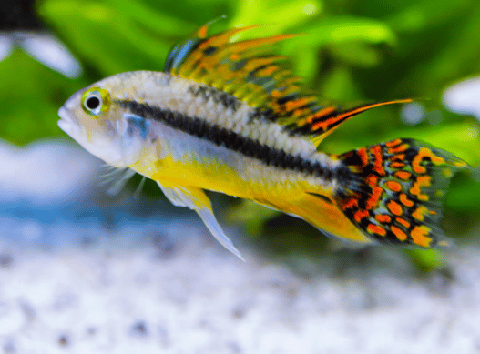
Apistogrammas are a South American cichlid that are commonly kept in blackwater community tank setups with a sand substrate. These fish are very easy to pair with plants and can be kept with all the species mentioned on this list. They will also appreciate floating plants.
2. Ram Cichlids
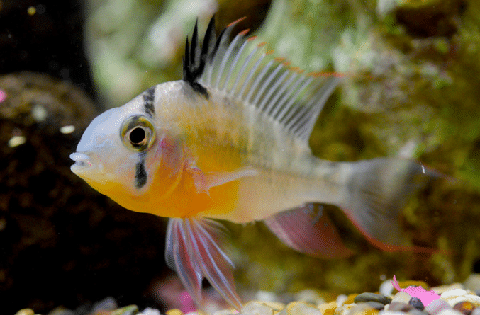
Another South American cichlid, rams are commonly kept in planted community tanks. However, these fish prefer higher-than-normal water temperatures compared to other fish, which can be stressful to some of the more sensitive species of plant. For the most part, Java fern, Anubias, crypts, Bolbitis, and Vallisneria will work in these warmer setups.
It should also be noted that ram cichlids love to burrow through the substrate, so root-feeder species might be torn up.
3. Angelfish
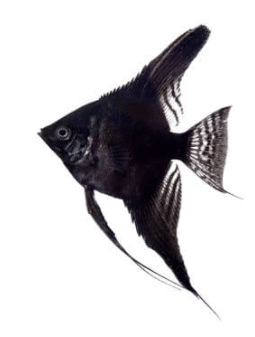
Angelfish are undeniably the most common cichlid to see in the average hobbyist’s aquarium. These fish thrive in slow-moving, heavily planted conditions. They are unlikely to nip at plants and like to take shelter in dense vegetation. However, some of the plants on this list, like Anubias and Crinum, require water flow to prevent algae from growing on their leaves.
Plants from these genera can still be kept with angels, but some algae control will be needed. This can be done through mechanical maintenance, using nerite snails, or other fish to gently eat algae off the surface of the leaves.
Julidochromis ornatus
Julidochromis are a common African cichlid from Lake Tanganyika. This lake has hard, basic water, and plants need to be able to acclimate to those conditions. Because of this, Java fern and Anubias are popular options, along with endemic species of Vallisneria.
4. Discus
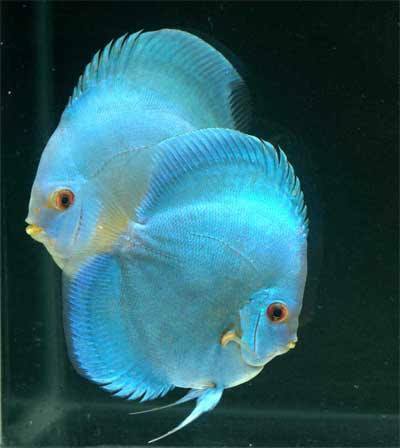
Discus are some of the most challenging fish to keep in the aquarium hobby due to their need for pristine water quality. Luckily, plants help maintain water parameters and can help reduce the maintenance needed to keep these South American cichlids. Unfortunately, discus also prefer higher-than-normal water temperatures, which needs to be considered when picking out different plants.
Like ram cichlids, some of the best warm water plant species include Java fern, Anubias, crypts, Bolbitis, and Vallisneria.
5. Geophagus altifrons
Geophagus altifrons are fun South American cichlids that look stunning in a planted aquarium. These fish can successfully be kept with all the plant species on this list, though it is possible they will dig up any planted ones.
Some Geophagus are kept in very low acidic water parameters, so some consideration may be needed. However, many plants can adapt.
6. Neolamprologus leleupi
A small Lake Tanganyika cichlid, Neolamprologous leleupi is similar to Julidochromis ornatus. These fish especially love to hide in and around caves, though they might interact with surrounding plants from time to time.
Like Julidochromis, Neolamprogous will pair well with Java fern, Anubias, and Vallisneria.
Why They Struggle

You may have heard the term ‘melting’. This is the word usually used to describe a newly added plant that suddenly dies. The plant often turns yellow or white and loses its leaves until the base of the stem rots (though the plant should be removed much before this!). There is a chance that the plant will come back and survive from this point, especially if you can propagate healthy pieces.
There are a few reasons plants might melt or die when added to a new aquarium.
- The water is hard and basic. Many aquarium plants prefer neutral water conditions around 7.0 pH. Unfortunately, Lake Malawi and Tanganyika have much higher pH and hardnesses (usually buffered by crushed coral or limestone), which many plants can’t withstand.
- The fish in the aquarium are destructive. Almost any type of African, Central, or South American cichlid has the capability of being destructive by digging up rooted plants. This can prevent the plant from becoming established and growing.
- The water temperature is too high. Many South American cichlids originate from warmer-than-average water temperatures above 80° F. Most aquarium plants have been acclimated to the 70° F range.
Conclusion
Cichlids are often kept only with each other, but that doesn’t mean you can’t add some biodiversity through plants. While the species of plant that can be kept is limited due to preferred cichlid water parameters and behavior, there are still a few that can quickly fill an aquarium. Some of these options include Anubias, Java fern, and Cryptocoryne.
- About the Author
- Latest Posts
I’m thrilled that you found Aquarium Store Depot! Here you’ll find information on fish, aquariums, and all things aquatics related. I’m a hobbyist (being doing this since I was 11) and here to help other hobbyists thrive with their aquariums! I adhere to a high quality Editorial Process and Review products with real life field usage and practical analysis.

